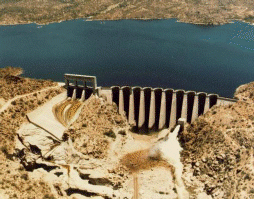 |
|  |
|
 |
What are buttress dams?
-Buttress dams can also be called Ambursen dams after the American engineer who greatly used this type of dam in the early 20th century.
Originally buttress dams were used in areas requiring irrigation, but where the land was not capable of supporting the size and weight of other types of dams. Generally buttress dams are built in wide valleys. The name "buttress" dam comes from the structure of the dam itself. The dam is supported at intervals by several buttresses, concrete slabs reinforced with steel, which form a watertight seal against the river. There are two main types of buttress dams: flat slab and multiple arch. Multiple arch dams are generally more expensive and time consuming to build. This is because the front of the dam consists of several arches that face upstream instead of just a flat front.
-The multiple arch dam pictured below is the Bartlett dam and it is the tallest dam constructed from concrete in the United States. It consists of 10 arches, 9 buttresses, and 2 gravity wing dams. The top of the dam is 287 feet high. 
|
Physics Involved in Buttress Dams
As with the arch dam and the gravity dam, the same forces must be considered for a buttress dam:
-Pressure applied by the water: For any type of dam the water applies pressure to the dam that is proportional to the depth of the water. In class we learned that the average pressure of the water times the area of the dam is equal to the force exerted by the water.
-The weight of the dam is also another factor involved. This is the downward force exerted by the concrete. To determine this the specific weight of the concrete is used. This is the volume of concrete times the specific weight of the concrete. The specific weight of the concrete, the ratio of the density of concrete compared to the density of water at 4 degrees Celsius. For concrete the specific gravity is 23.6 N/m3. The weight of the dam times gravity is the total downward force that is exerted by the dam.
-The normal force is the upward force that is exerted by the Earth. Since the dam is not in motion, the normal force provides equilibrium for the weight. Thus, the normal force for a dam is equal but opposite in direction to the weight of the dam times gravity.
|
|
|

|
|



